If you’re looking for a tasty and healthy way to use up some of your zucchini this summer, why not try fermenting them into zucchini pickles? Not only is this the easiest way to preserve your zucchini, but it’s also a perfect way to introduce some beneficial bacteria into your diet. Plus, with the hot summer days ahead, you don’t want to be stuck in a hot kitchen, and fermenting is a great way to keep your kitchen cool.
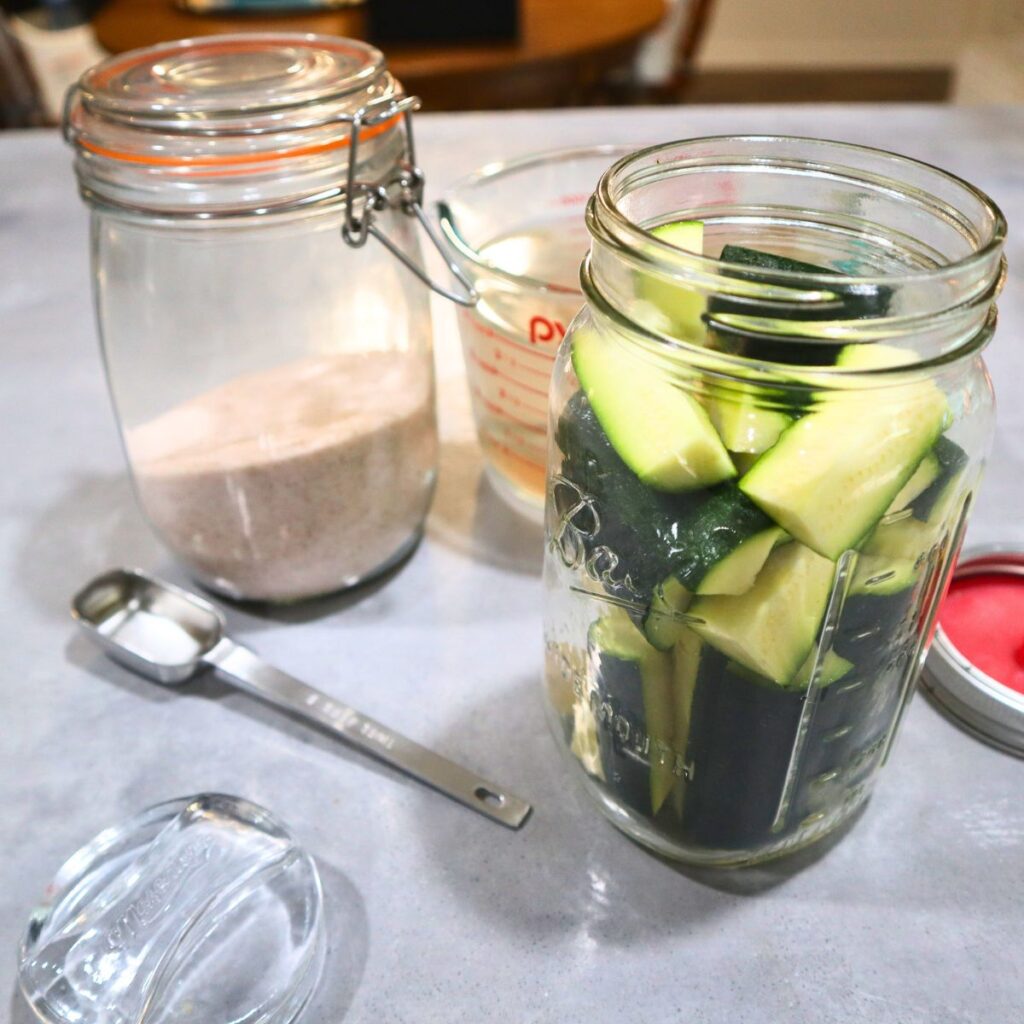
Discloser Note:
This post may contain affiliate links, which means I make a small commission at no extra cost to you. See my full disclosure here.
What Is The Difference Between Fermenting And Pickling?
It’s a common misconception that pickling and fermenting vegetables are the same thing, but they’re actually two different processes. Pickling is a preservation method that uses an acidic solution, like vinegar, to preserve vegetables and give them a tangy flavor. On the other hand, fermenting vegetables is a natural process that uses beneficial bacteria to break down the sugars in the vegetables and create lactic acid, which gives the vegetables a sour flavor. While both methods can be used to preserve vegetables and add flavor, fermenting vegetables also has the added benefit of creating gut-friendly probiotics.
I call these fermented zucchini “pickles” because they look like pickles and can be used in dishes the same way a pickle can. However, this recipe is ultimately for fermented zucchini and not pickled zucchini.
If you are new to fermented foods then you may be most familiar with sauerkraut. Sauerkraut is just the name that we give to fermented cabbage after it has been fermented.
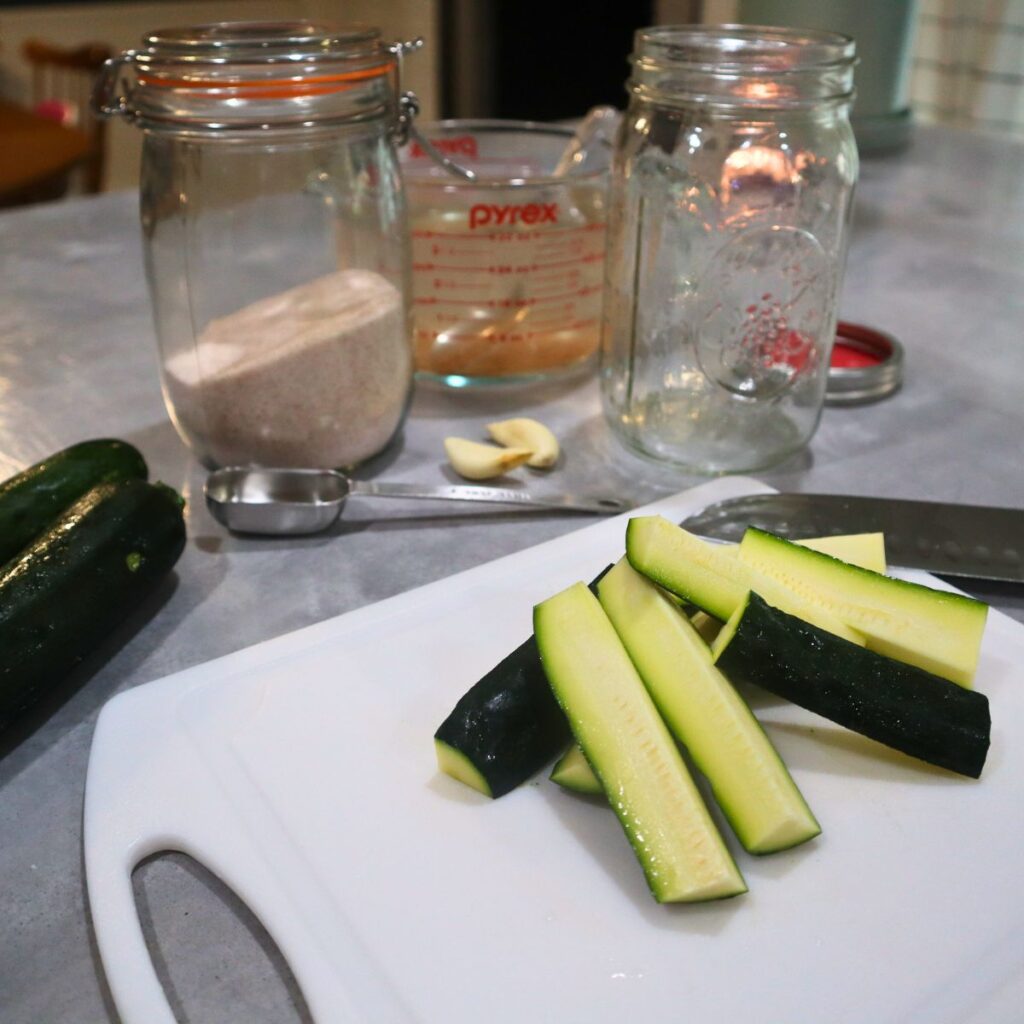
How Do You Ferment Zucchini?
To start, you’ll need some clean jars and some fresh zucchini. Wash the zucchini and slice them into thin rounds or spears. Pack the zucchini tightly into the jars, leaving about an inch of headspace at the top. I typically use quart mason jars but if you can easily make this in smaller jars if you prefer. This lacto-fermentation method allows you to make as much zucchini as you want so any size jar that you have will work.
Next, you’ll want to make a brine. Combine 4 cups of tap water with 2 tablespoons of salt in a large bowl, and stir until the salt is completely dissolved. Pour the brine over the zucchini in the jars, making sure to cover them completely.
Now it’s time to add some flavor. Peel a few garlic cloves and add them to the jars. You can also add some fresh herbs or spices, like dill or mustard seeds, for extra flavor. My husband is a big fan of adding spice so some red pepper flakes would also be a great addition here.
To make sure the zucchini stays submerged in the brine, you’ll need a fermentation weight. You can buy special weights for this purpose, or you can use a small glass weight or a clean stone that fits inside the jar. Place the weight on top of the zucchini, making sure everything is submerged.
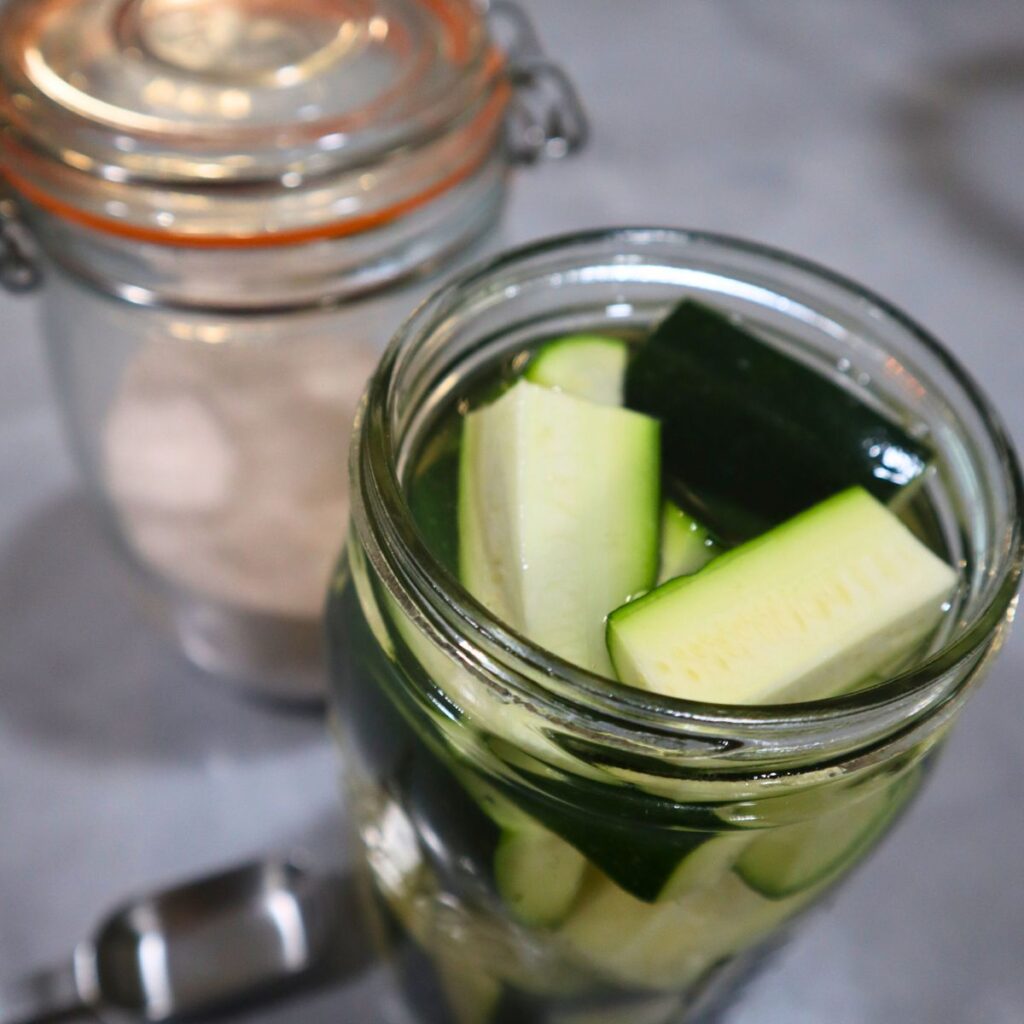
Finally, you’ll need a fermentation lid. This is a special lid designed for fermenting, or you can use a regular jar lid that you will need to burp daily. Don’t use airtight lids, as pressure can build up and cause the jar to explode. The fermentation lids are so much less hassle and very affordable on Amazon.
Place the jars in a cool, dry place out of direct sunlight at room temperature for 3-5 days. You can check on the fermentation process by tasting the zucchini pickles. They should start to develop a tangy, sour flavor as lactic acid bacteria produce acid in the brine. You can also see bubbles forming on top of the jar, which is a sign that the fermentation process is happening.
After 3-5 days, you can move the jars to a cooler spot, like a fridge or root cellar, to slow down the fermentation process. The longer the zucchini pickles ferment, the more sour and tangy they will become. If you are new to fermented foods you will probably want to move your fermented zucchini to the fridge around the 3 day point. However, if you are already in love with the tangy taste of fermented foods you can wait until the 5 day point.
When you’re ready to eat your zucchini pickles, remove the weight and fermentation lid and replace with a regular lid. Store the jars in the fridge, where they will keep for several months.
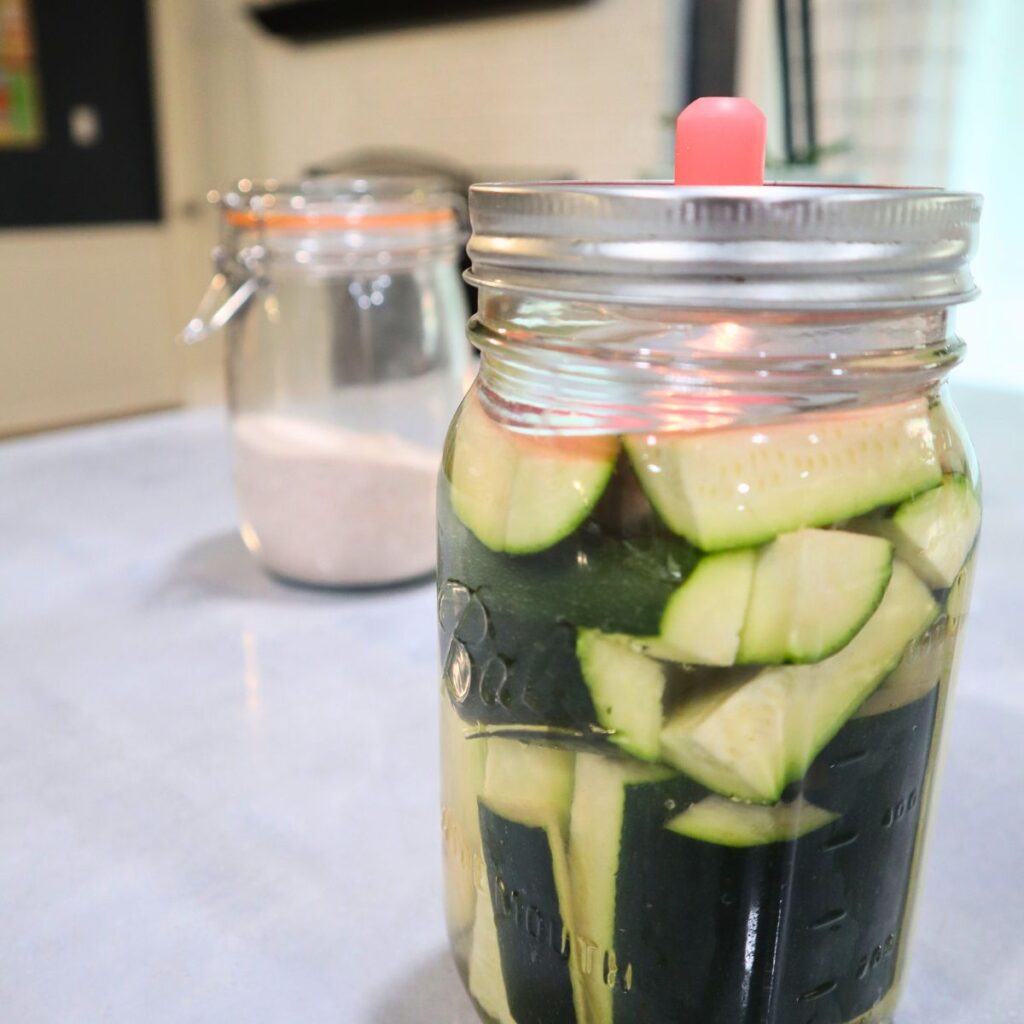
How Long Does Fermented Zucchini Last?
If you’re wondering how long your fermented zucchini will last, the good news is that it can keep for several months in the fridge. Because the fermentation process creates an acidic and salty environment, it helps to preserve the zucchini and prevent spoilage. However, it’s important to make sure that you use clean jars and utensils when fermenting, and that the zucchini is completely submerged in the brine to prevent any mold or bacteria growth. Additionally, storing the fermented zucchini in airtight jars in the fridge can help to prolong its shelf life. So go ahead and enjoy your delicious and gut-friendly fermented zucchini for weeks to come!
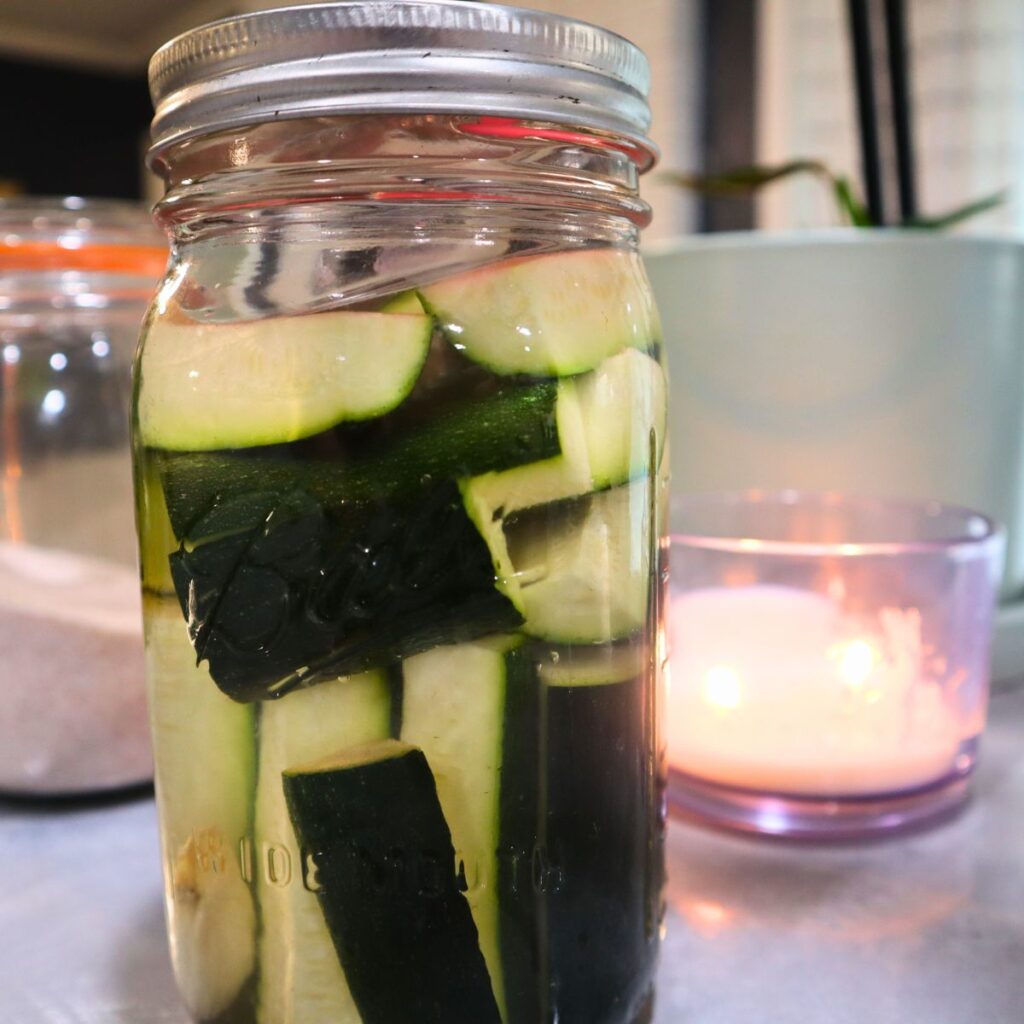
Can You Eat Fermented Zucchini?
Yes!
Not only is fermented zucchini delicious and a great way to use up your summer zucchini crop, but they also have some amazing health benefits. Fermented foods like zucchini pickles are rich in beneficial bacteria, which can help to improve digestion, boost the immune system, and support overall gut health. Plus, they’re a great way to add some flavor and variety to your diet. I don’t know about you but when we have a bumper crop of zucchini finding a unique way to eat or preserve it that has the added benefit of good gut bacteria is an all around win for me. Plus on a hot summer day the last thing I want to do is heat up my kitchen and this fermented zucchini doesn’t require turning on the oven at all.
So why not give fermenting zucchini a try this summer? It’s a simple and easy process that will yield tasty and healthy results. Just remember to keep everything clean and use fresh ingredients, and you’ll be on your way to a delicious batch of zucchini pickles in no time.
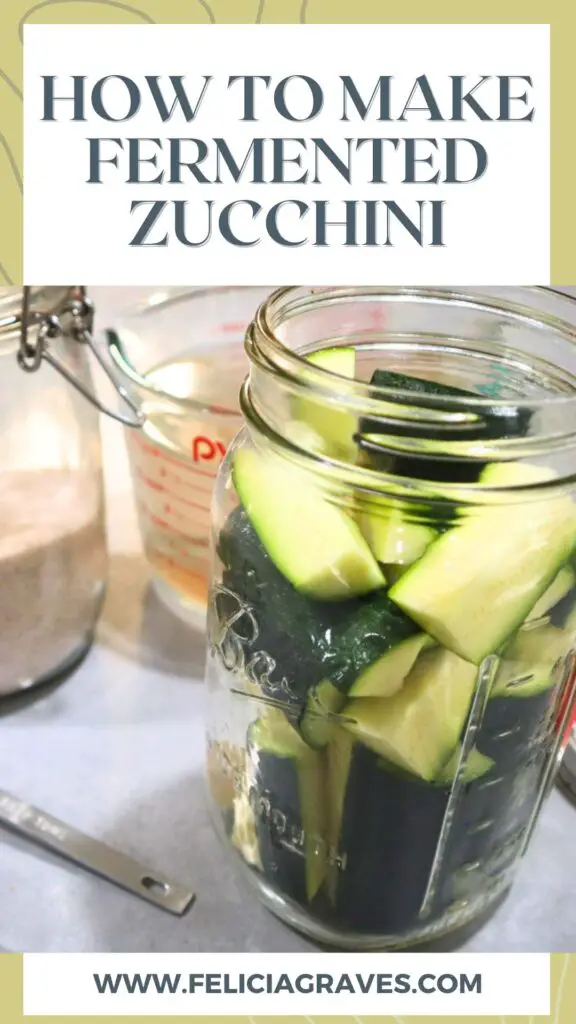
Fermented Zucchini Pickles
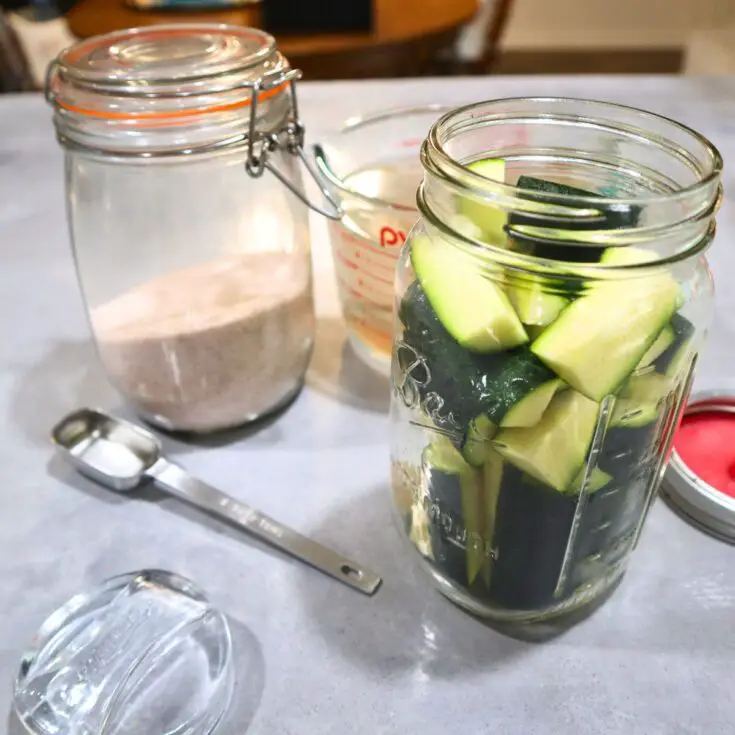
If you're looking for a tasty and healthy way to use up some of your zucchini this summer, why not try fermenting them into zucchini pickles? Not only is this the easiest way to preserve your zucchini, but it's also a perfect way to introduce some beneficial bacteria into your diet.
Ingredients
- Zucchini, cut into spears or rounds
- 2 Tbsp salt
- 4 cups water
Instructions
- Combine the water and salt and stir until the salt has dissolved. This will create your brine.
- Pack the zucchini into your jar and pour over the brine leaving a one inch headspace.
- Place a glass fermentation weight on top of the zucchini so that the vegetables all stay below the brine.
- Put a fermentation lid on your jar.
- Leave the jar in a cool, dry place for 3-5 days until the zucchini reaches your preferred level of tangyness.
- Replace the fermentation lid with a regular lid and store in the fridge.
Notes
If you like you can add different flavors to your fermented zucchini. Peel a few garlic cloves and add them to the jars. You can also add some fresh herbs or spices, like dill or mustard seeds, for extra flavor.
Place the jars in a cool, dry place out of direct sunlight at room temperature for 3-5 days. You can check on the fermentation process by tasting the zucchini pickles. They should start to develop a tangy, sour flavor as lactic acid bacteria produce acid in the brine. You can also see bubbles forming on top of the jar, which is a sign that the fermentation process is happening.
After 3-5 days, you can move the jars to a cooler spot, like a fridge or root cellar, to slow down the fermentation process. The longer the zucchini pickles ferment, the more sour and tangy they will become. If you are new to fermented foods you will probably want to move your fermented zucchini to the fridge around the 3 day point. However, if you are already in love with the tangy taste of fermented foods you can wait until the 5 day point.
When you're ready to eat your zucchini pickles, remove the weight and fermentation lid and replace with a regular lid. Store the jars in the fridge, where they will keep for several months.

Leave a Reply